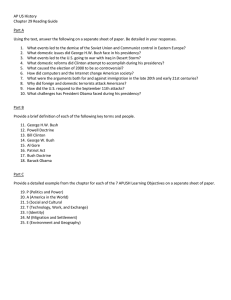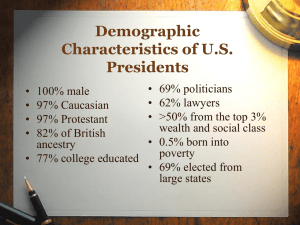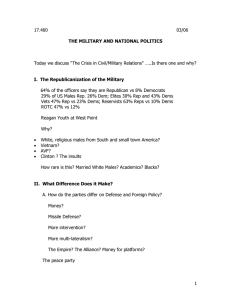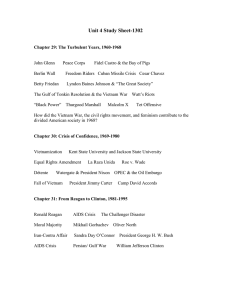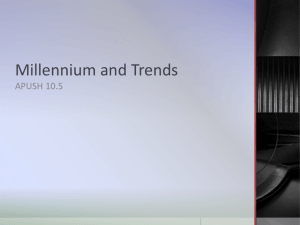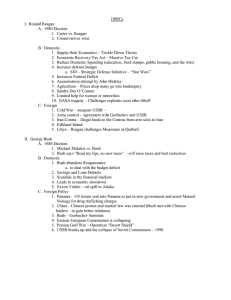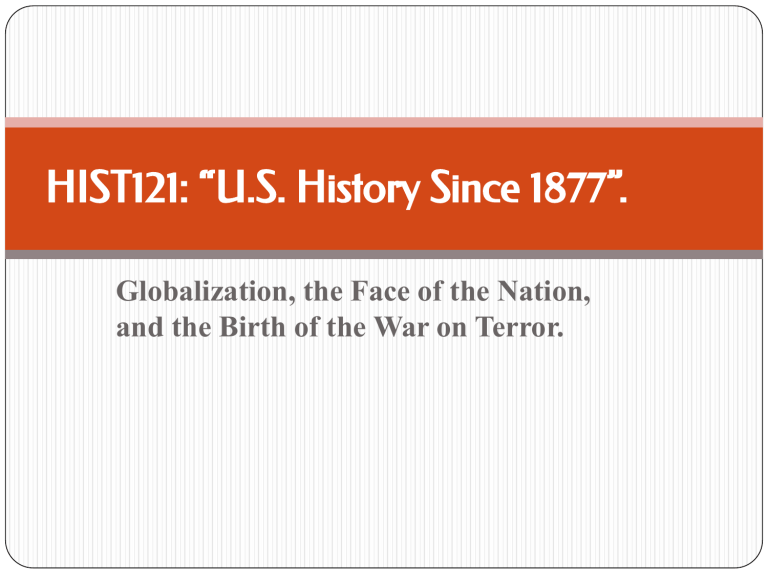
HIST121: “U.S. History Since 1877”. Globalization, the Face of the Nation, and the Birth of the War on Terror. County-by-county political change, Presidential elections 1996-2020. Note: misleading, people (concentrated in cities) vote not land! Key Terms (possible future ID terms). ⚫ “The New Democrats”. ⚫ William Jefferson Clinton (1946- , p1993-2001). ⚫ Newt Gingrich (1943- ) and the “Contract for America”. ⚫ “The Greying of America”. ⚫ The New “New Immigrants” – primarily from Latin America & Asia. ⚫ “The Information Revolution”. ⚫ “Globalization”. ⚫ Narrowcasting – e.g. Conservative Talk Radio, Fox News, MSNBC etc. ⚫ Rupert Murdoch (1931- ) – for me: Australian-born creator of modern political dysfunction in Australia, the United Kingdom (Britain), and the United States. ⚫ Bush v. Gore (2000). ⚫ The Bush Doctrine (2001). ⚫ Afghan War (2001-Present). ⚫ The Iraq War (2003-2011). Plus later insurgencies including Islamic State (ISIS). ⚫ Hurricane Katrina (August 2005). ⚫ “Subprime” Mortgages. ⚫ The Presidential Election of 2008. Politics: “The New Democrats”. ⚫ “The New Democrats” of the 1990s onward are an ideologically “centrist” faction ⚫ ⚫ ⚫ ⚫ within the Democratic Party. They emerged in response to repeated defeats by Republicans first under Reagan and then George H.W. Bush (Bush Sr.). Characterize their approach as the “Third Way” between Left and Right, and support neoliberal economic policies. This all happened under the leadership of William Jefferson (or “Bill”) Clinton, a defining figure in modern American politics. Born William Jefferson Blythe in Arkansas in 1946. Attended Georgetown University, won a prestigious Rhodes Scholarship to study Philosophy, Politics and Economics (PPE) at the University of Oxford. On returning from the UK, he attended Yale Law School meeting his wife Hillary. In 1974 he returned to Arkansas to become a professor at the University of Arkansas. Ran for the U.S. House in 1974 (narrowly lost), elected Arkansas Attorney General in 1976, and Governor in 1978 (aged just 32) referred to as the “Boy Governor”. Lost his campaign for reelection in 1980, but won again in 1982 and remained Governor until 1992. Wins out in a protracted and bloody battle for the Democrats nomination for President in 1992. The story was fictionalized in the 1996 novel Primary Colors by Joe Klein, in 1998 released as the film of the same name, starring John Travolta as “Jack Stanton” (Clinton). The 1992 Election and The Clinton Presidency. Demographics. “The Greying of America”: common phrase used in recent decades to discuss the rising average age of the population in the United States. Often used in particular in relation to the ongoing aging of the baby boom generation – sometimes also called the “grey tsunami” (highlighted above) who are now increasingly approaching retirement age, and will need young workers to pay taxes in to government coffers to keep on funding programs such as medicare and social security on which they will increasingly rely. Technology. ⚫ Development of computers, first begun in the 1940s accelerates in the 1970s resulting in the emergence of giant firms such as Microsoft and Apple. ⚫ “Information Revolution” (sometimes called the “Third Industrial Revolution”): the acceleration of the speed and availability of information due to computer and satellite systems. Linked above all to the emergence of the internet as a tool used by ordinary people in their everyday lives. ⚫ Biotech has the potential to offer similar progress through measures such as the Human Genome Project –mapping genetic material in 24 human chromosomes. Similar techniques used by big agribusiness for developments such as Genetically Modified (GM) Crops to produce new strains of various grains and even livestock that were hardier (able to resist frost) or with greatly increased yields. Very controversial – and for the most part pervasive (everywhere) but unreported in the United States where big agribusiness has successfully lobbied Congress to oppose the labeling of GM crops (unlike in many other developed nations). Economics. ⚫ Technological innovation especially related to the internet changed the mode of operation for businesses around the world. ⚫ This led to even faster growth of certain franchises, most famously in the United States and around the world, McDonalds, Starbucks, and even Walmart. ⚫ Amazon.com (launched in 1995) challenged and continues to present an existential threat to existing physical book, dvd, and video game retailers and much else. Netflix etc. ⚫ “Globalization”: the development of an increasingly integrated economy, as trade and investment expand worldwide. Talked about as a new phenomenon, and due to technological breakthroughs to some degree is new, but is also part of a much longer history of economic integration – marked by cyclical collapses in international trade. ⚫ “Downsizing” ongoing process of cutting back labor forces (sometimes management) by businesses, driven by tech. change and increasing centralization it makes possible. ⚫ “Deskilling” of workers occurring as increasingly mechanization comes to new previously too complex tasks, increased mobility (desired or not) in job market – meaning the old model of leaving school or university and finding your one job for life is no longer viable. ⚫ New power relationships between big multinational corporations and State and National Governments where jurisdictions “bid” (by offering tax breaks) to get big business to relocate divisions within their boundaries. Narrowcasting: Culture and News. Religion and Religiosity. Bush v. Gore (2000). September 11, 2001. ⚫ ⚫ ⚫ ⚫ ⚫ ⚫ ⚫ ⚫ Al Qaeda attacks on New York and Washington. Follows smaller attacks on U.S. embassies in Africa (Kenya and Tanzania in 1998), and on the USS Cole off Yemen in 2000. Almost 3000 people die, Bush declares a “War on Terror” intervenes in Afghanistan (Dec. 2001) and invades Iraq in March 2003 – with tiny “Coalition of the Willing” (as against huge internationalist coalition of 34 countries that liberated Kuwait in the First Gulf War in 1990). Bush Doctrine: denounces terrorist networks and claimed authority to wage war against any force that endangered American security. Passed the Patriot Act in 2001 in response to attacks, greatly increasing surveillance at home and abroad … extended repeatedly by Presidents Obama & Trump. Expired summer 2020? Despite Bush claiming victory in “Operation Iraqi Freedom” on the deck of the Abraham Lincoln aircraft carrier the war went on to kill almost 5000 U.S. and allied foreign troops, and anywhere between 100,000 and 700,000 civilians depending on which survey The Lancet, Iraq Body Count etc. you believe. ISIS emerges out of Sunni resistance to U.S. Afghanistan: c.3,500-4,000 U.S. and allied (NATO) troops killed, between 25,000 and Hurricane Katrina (2005). ⚫ ⚫ ⚫ ⚫ ⚫ ⚫ “The End of Boom and Bust”? The 2008 Crash. Throughout the 1990s and early 2000s market and political leaders believed they had found an economic recipe for growth without causing the cyclical recessions that were characteristic of capitalist economies. This recipe was termed “The Great Moderation” and was based on deregulation of the market. With hindsight, we see the warning signs throughout the Bush Jr. years with very sluggish job growth and other indicators. The Financial Sector emerged as one of the most dynamic and largest areas of the economy. The New Democrats, backed by their Republican adversaries, removed New Deal era regulation of the financial sector allowing the trading of “derivatives” – very basically: allowing “betting” on future market conditions (oil and other commodity prices, interest rates etc.). These “reforms” are often called “Rubinomics” for the former Goldman Sachs employee Robert Rubin (1938- ) who headed Clinton’s so-called “brain trust”. Under George W. Bush’s administration, Frank Paulson (another former Goldman Sachs employee) became Secretary of the Treasury in 2006 and oversaw even greater deregulation, removing legislation requiring large banks to hold reserves of capital to cover their debts. Bush administration also contributed to the downturn by taking Clinton’s budget surpluses and turning them in to military spending and record tax-cut driven deficits reminiscent of the Reagan years. When the crash came, the country was wholly unprepared due to government policy (see above) but also a massive housing bubble, and in particular the growth of the so-called “subprime” mortgage market where mortgage rules were loosened and lenders aggressively sold buyers homes they couldn’t afford under traditional lending models. Housing bubble collapse caused financial panic. Bush administration and Federal Reserve respond by first helping J.P. Morgan Chase to buy troubled Lehman Brothers Bank. When this failed to stop collapse they respond with huge Emergency Economic Stabilization Act (EESA) of 2008, including the TARP program which – based on the claim big banks were “too big to fail” – allowed the spending of $700 Billion just to prop up Wall Street firms. The Election of 2008: and the limits of political “color-blindness”. ⚫ Conclusions. With their realignment rightward under Bill Clinton the “New Democrats” became a political force to be reckoned with by moving on to the new Reaganite “center ground” of politics. ⚫ Clinton’s Presidency oversaw a period of intense reform, such as welfare reform, much of which broke with traditional Democratic policies. The country also experienced a period of sustained economic growth: average GDP growth at 4% per year, and an unemployment rate at under 2%. ⚫ Clinton was impeached by the House of Representatives for lying about sexual contact with Monica Lewinsky a White House intern, the charges were dismissed by the Senate … but this scandal marred what many “centrists” might otherwise have remembered as a great American Presidency. ⚫ Demographically the country changed markedly in the last decades of the c.20th in to the 21 st: it “greyed” remarkable (and will continue to do so as baby boomers retire), the center of population crossed the Mississippi river into Missouri and the historical West, and the New “New Immigration” from the 1970s on saw immigration shift from Europe to the majority of migrants coming from Latin America and Asia. ⚫ Technological change, primarily the emergence of the internet, drove great economic and cultural shifts such as increasing franchising and deskilling of workers, and phenomena such as “narrowcasting” of entertainment (and news/infotainment): creating the modern situation of two politically “parallel Americas”. ⚫ The Bush-Gore Election of 2000 was one of the closest and most contentious in American history, and was ultimately decided by the Supreme Court, which ordered the Florida recounts stopped and effectively awarded the election to the Republicans in Bush v. Gore (in a partisan-defined vote). ⚫ The September 11th attacks of 2001 began a new era, generally called the “War on Terror,” of intense security fears at home and wars abroad. Hurricane Katrina (2005) and other developments (Guantanamo Bay, Abu Ghraib Prison, and John Bolton’s appointment as ambassador to the U.N.) shook faith in Bush administration. ⚫ The economic collapse of 2008 had both purely economic and political (legislative) roots as politicians of both parties acted to roll-back New Deal Era regulations placed on the market. ⚫ I WILL BE REWRITING MY LECTURES IN NEXT YEAR OR SO TO UPDATE COURSE.
